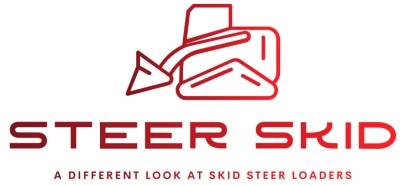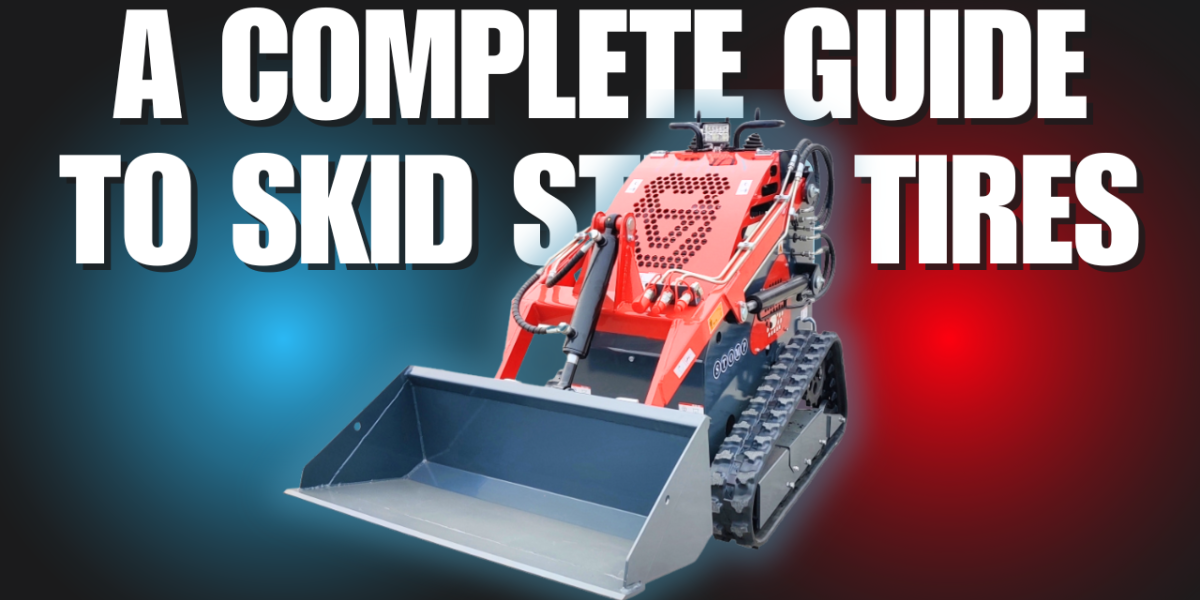Introduction
In construction, landscaping, and agriculture, the correct pair of skid steer tires may make all the difference. It’s not just about going from point A to point B; it’s about doing it quickly, securely, and precisely. For best performance and lifetime of your equipment, you must choose skid steer tires specifically for your application. This book will take you through everything you need to know to make a wise choice.
Understanding Skid Steer Tires
Differences Between Pneumatic and Solid Tires
One of the first choices you will have to make about skid steer tires is whether to choose pneumatic or solid tires. For operators who put in a lot of hours, pneumatic tires—which are air-filled and provide a better ride—may be advantageous. They need constant care, however, and are more prone to punctures. Conversely, solid tires are perfect for demanding environments as they are very resilient and puncture-proof. Their stiffness can, however, make the skid steer more prone to wear and less comfortable.
How to Determine the Right Size for Your Skid Steer
Maintaining the balance and stability of your skid steer depends on your tire size choice. Usually seen on the sidewall, the tire size shows the width and diameter of the tire. To prevent any safety dangers and operational problems, make sure your tire size fits the specs of your skid steer. If you’re not sure, consulting the handbook or a specialist for your device will provide further direction.
Application-Specific Tires
Tires for Construction Sites
Tykes for construction sites must be able to resist big weights and uneven ground. Key here are traction and durability. Choose tires composed of premium rubber compositions with great cut and abrasional resistance. Additionally helpful for providing the required grip in muddy or uneven environments are deep treads.
Tires for Landscaping
Landscape calls for a new kind of tire feature. Minizing ground disturbance is the main focus here in order to preserve fragile surfaces like gardens and lawns. To more equally distribute the weight, search for tires with a shallower tread pattern and a larger surface area. These characteristics provide enough traction and help lower the ground’s danger of damage.
Tires for Agricultural Use
In agriculture, stability and flotation rule most importantly. Larger footprints from agricultural skid steer tires will help to more equally distribute the weight of the machine, therefore minimizing soil compaction. These tires should also be designed to provide stability on uneven ground so that the machine may run effectively without being caught or toppling over.
The Fundamentals of Skid Steer Tires
3 Requirements When Looking for a Tire Solution
- Tire Size: Machine size, manufacture, and model all tend to affect tire measurements. When purchasing a new tire or a replacement skid steer tire, these specifics come in really helpful.
- Tire Design: Understanding your application and the ground conditions—including their degree of severity—helps you decide on the correct design for your tires.
- Tire Construction: Every tire structure offers advantages of various kinds. Your equipment, application, work hours, and general use will determine whether solid tires, flat-proof tires, foam-filled tires, or no air skid steer tires you require.
Details about Your Tire’s Sidewall
Usually including all the necessary information, a tire’s sidewall consists of:
- Brand, product name, and tire type
- Serial number
- Tire size
- Load and Inflation indications
- Safety procedures
Tire Size for Replacement Tires
Using OEM-recommended dimensions can help you choose replacement skid steer tires. In case OEM sizes are not known, you might take into account appropriate equivalents.
Tire Ratings
- For radial tires, see Star Rating (SR).
- Applied to bias-ply tires, ply rating (PR)
These ratings will let you ascertain the tire construction’s relative strength. It reminds one that the tire can carry bigger weights the higher its SR or PR.
Skid Steer Tire Technologies
Bias Tires & Radial Tires
| Bias Tires | Radial Tires |
|---|---|
| Crossed nylon threads make up a bias or diagonal tire. | The metal belt of a radial tire is oriented radially, and the flexible carcass is likewise. |
| They provide superior stability, have stronger sidewall puncture resistance, and are more reasonably priced. | They ride better, have higher grip, heat resistance, superior tread impact resistance, and longer lifetime. |
Solid Tires
Usually considered pneumatic tires, bias and radial tires are filled with air. Because solid tires contain rubber compounds in them, they are perfect for heavy-duty jobs with significant puncture concerns. They will help you work on recycling or garbage initiatives as well as on scrapyards. Used properly, solid tires may be maintenance-free.
Tread Patterns
- The Direction of the Pattern: Depending on the ground situation, selecting a tire with appropriate design may improve the general equipment performance. Although zigzag type, non-directional patterns function better for hard or mixed grounds; directed lug type tread patterns are more appropriate for soft terrain.
- Lug-to-Void: It guides you to find the correct task pattern. Great wearing performance will come from a 100% lug tire or smooth tread. Still, it often slips on surfaces other than asphalt or dry concrete.
- Lug or Original Tread Depth (OTD)
An excellent gauge of the tires’ general life performance is Lug or Original Tread Depth (OTD). If you want to operate on soft surfaces or muddy ground, you should give this factor some thought.
Factors to Consider When Choosing Tires
Budget Considerations
Your tire selections will obviously depend on your budget. Although less expensive choices might be appealing, by lowering downtime and maintenance costs, investing in better-quality tires can save you money over time. When deciding, take the complete cost of ownership into account, considering possible maintenance costs and tire lifetime.
Environmental and Weather Conditions
Crucially important considerations are the surroundings and weather conditions you will be operating in. For example, tires meant for very cold may not work in hot, dry environments and vice versa. Evaluate the normal circumstances of your working areas and choose tires especially made to withstand such surroundings.
Load Capacity and Tire life span
Load capacities needed for various uses vary. Choose tires that will allow your skid steer and any accessories you will be utilizing to withstand their weight. Tires may be prematurely worn by overloading, and potentially deadly blowouts result. Take also into account the tires’ projected lifetime. By investing in robust, premium tires, your skid steer’s operating life will be extended, and greater value over time will be obtained.
New Technology and Innovations
Latest Advancements in Skid Steer Tire Technology
The tire business is changing all the time and new technologies meant to solve shared problems are developing. For instance, airless tire designs are growing in favor as they provide the comfort of pneumatic tires along with the durability of solid tires. Another development are self-sealing tires, which automatically seal punctures to save downtime.
How Innovations Address Common Challenges
These technical developments seek to address some of the most often occurring issues equipment operators deal with. While self-sealing tires save the time and effort required for maintenance, airless tires, for example, remove the chance of flats. These developments not only raise the dependability and performance of your skid steer but also increase safety and save general running expenses.
Maintenance and Care Tips
Best Practices for Tire Care and Maintenance
Extending the lifetime of your skid steer tires depends on good care and maintenance. To eliminate potential damage-causing material, routinely clean the tires Periodically rotate the tires to guarantee even wear and look for evidence of damage or too much wear that would point to a need for replacement.
Importance of Regular Inspections and Tire Pressure Checks
Finding possible problems before they become major ones depends on routine inspections. Look for cuts, punctures, or aberrant wear patterns that can impact tire performance. Furthermore, essential for best performance and lifetime is keeping the right tire pressure. Both under- and over-inflation may cause unequal wear and lower the tire’s performance.
Conclusion
Maximizing the productivity and safety of your operations depends on selecting application-specific skid steer tires. Knowing the many kinds of tires that are on the market and weighing variables such load capacity, environmental circumstances, and cost will help you to make a wise choice that will help your company going forward. See a specialist if you need customized counsel fit for your particular situation. Purchasing the correct tires now might result in substantial savings and enhanced performance going forward.
See our team or visit our website for more specific information and professional advice. We are here to guide you toward the optimal decision for your skid steer requirements.
Following these rules and thinking through the particular requirements of your application will help you to make sure your skid steer has the proper tires for the task. Happy tire shopping!

